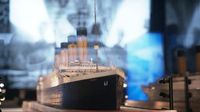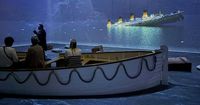On April 15, 1912, the RMS Titanic, once heralded as unsinkable, met a tragic fate when it collided with an iceberg during its maiden voyage across the North Atlantic. The catastrophic event resulted in the loss of 1,514 lives out of the 2,220 passengers and crew on board, leaving a lasting imprint on maritime history. Now, over a century later, the story of the Titanic is brought back to life in an immersive exhibition titled "Titanic: Eine immersive Reise," set to open on April 17, 2025, in Hamburg's Expo-Halle.
The exhibition aims to provide a deeper understanding of the Titanic's tragic sinking, moving beyond the cinematic portrayals that have shaped public perception. According to Malte Fiebing-Petersen, the chairman of the German Titanic Association, the exhibition seeks to dispel myths popularized by James Cameron's 1997 film, which, while iconic, presents historical inaccuracies. "Passengers like Jack and Rose would never have reached the bow," he noted, emphasizing the exhibition's commitment to authenticity.
Spanning approximately 2,550 square meters, the exhibition offers visitors a chance to experience life aboard the Titanic, from the opulent dining rooms to the cramped crew quarters. Attendees will receive a personal boarding pass at the beginning of their journey, allowing them to follow the story of either a passenger or a crew member. At the end of the tour, they can check an information wall to see whether their character survived the disaster.
Among the highlights of the exhibition are around 300 original artifacts, which provide a tangible connection to the past. These items, sourced from other ships of the era, such as the Titanic's sister ships, the Olympic and Britannic, enhance the authenticity of the experience. Visitors will encounter meticulously recreated spaces, including a first-class cabin and one of the ship's radio rooms, designed to transport them back to the early 20th century.
The exhibition also features cutting-edge technology to engage visitors more deeply. A free audio guide is available in both German and English, ensuring that everyone can appreciate the rich history of the Titanic. Additionally, 360-degree projections will immerse attendees in the ship's environment, with a particularly striking installation allowing visitors to sit in a lifeboat while witnessing the Titanic sink in a darkened hall, stars twinkling overhead.
Perhaps the most thrilling aspect of the exhibition is the virtual reality experience, which lasts 12 minutes and takes participants on a simulated dive to the Titanic's wreck site. This unique opportunity allows visitors to explore the ocean floor and gain a firsthand perspective of the ship's final resting place.
The "Titanic: Eine immersive Reise" exhibition is set to run at least until the end of summer 2025, with opening hours designed to accommodate a wide audience. It will be open from 10 AM to 6 PM on Mondays, Tuesdays, Wednesdays, Sundays, and public holidays, extending to 8 PM on Thursdays, Fridays, and Saturdays.
Ticket prices are structured to be accessible, with time slot tickets priced at 26 euros for adults during weekdays and 28 euros on weekends and public holidays. Reduced tickets are available for 22 or 24 euros, while children and teenagers up to 15 years old can enter for 18 euros on weekdays and 20 euros on weekends. A family ticket is also offered at 80 euros on weekdays and 94 euros on weekends. For those who prefer flexibility, monthly flex tickets are available for 32 euros for adults and 24 euros for children and teenagers, with free entry for children under seven years old. Participation in the virtual reality tour incurs an additional fee of six euros.
To celebrate the opening of the exhibition, preview days will be held on April 15 and 16, 2025, offering discounted admission prices. This initiative is expected to attract a large number of visitors eager to learn more about the Titanic's legacy.
For those planning to visit, the exhibition is conveniently located in Hamburg's Rathausviertel at Neß 9. There are 70 designated paid parking spaces available immediately outside the venue. Public transportation options are also plentiful, with nearby bus stops and S-Bahn stations, making it easy for visitors to access the exhibition.
As Fiebing-Petersen aptly put it, "The sinking of the Titanic fascinates people because it shows that humanity is not the master of natural forces." This exhibition offers a respectful way to commemorate the tragedy while educating attendees about the realities of that fateful night.









